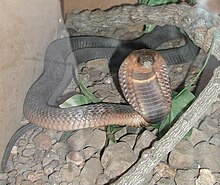Egyptian cobra
| Egyptian cobra | |
|---|---|
 |
|
| Scientific classification | |
| Kingdom: | Animalia |
| Phylum: | Chordata |
| Class: | Reptilia |
| Order: | Squamata |
| Suborder: | Serpentes |
| Family: | Elapidae |
| Genus: | Naja |
| Species: | N. haje |
| Binomial name | |
|
Naja haje (Linnaeus, 1758) |
|
 |
|
|
Distribution of the Egyptian Cobra
|
|
| Synonyms | |
The Egyptian cobra (Naja haje) is a species of cobra found in Africa. It is one of the largest cobra species native to Africa, second to the forest cobra (Naja melanoleuca).
Naja haje was first described by Swedish zoologist Carolus Linnaeus in 1758. The generic name naja is a Latinisation of the Sanskrit word nāgá () meaning "cobra". The specific epithet haje is derived from the Arabic word hayya (حية) which literally means "snake".
The Egyptian cobra is one of the largest cobras of the African continent. The head is large and depressed and slightly distinct from the neck. The neck of this species has long cervical ribs capable of expanding to form a hood, like all other cobras. The snout of the Egyptian cobra is moderately broad and rounded. The eyes are quite big with round pupils. The body of the Egyptian cobra is cylindrical and stout with a long tail. The length of the Egyptian cobra is largely dependent on subspecies, geographical locale, and population. The average length of this species is between 1 and 2 metres (3.3 and 6.6 ft) in length, with a maximum length of just under 3 metres (9.8 ft). The most recognizable characteristics of this species are its head and hood. The colour is highly variable, but most specimens are some shade of brown, often with lighter or darker mottling, and often a "tear-drop" mark below the eye. Some are more copper-red or grey-brown in colour. Specimens from northwestern Africa (Morocco, western Sahara) are almost entirely black. The ventral side is mostly a creamy white, yellow brown, grayish, blue grey, dark brown or black in colouration, often with dark spots.
Dorsal scales on the midbody 19-20, ventral scales 191-220, subcaudal scale is paired, subcaudal scales 53-65, anal plate is single, upper labials 6, upper labials to the eye 3+4, preoculairs 1, postoculairs 3 (but can also be 2), suboculairs 2–3, supralabials 7 (rarely 6 or 8), lower labials 8, temporal 1+2/1+3 varying.
...
Wikipedia
